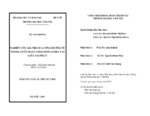
Please use this identifier to cite or link to this item:
http://dulieuso.hmu.edu.vn/handle/hmu/1901| Title: | Nghiên cứu giá trị của cộng hưởng từ trong chẩn đoán cholesteatoma tai giữa tái phát |
| Authors: | Lê Văn, Khảng |
| Advisor: | GS.TS. Phạm Minh, Thông PGS.TS. Đoàn Thị Hồng, Hoa |
| Keywords: | 62720165;Chẩn đoán hình ảnh |
| Issue Date: | 2019 |
| Abstract: | THÔNG TIN TÓM TẮT NHỮNG KẾT LUẬN MỚI . CỦA LUẬN ÁN TIẾN SĨ. Tên đề tài: Nghiên cứu giá trị của cộng hưởng từ trong chẩn đoán cholesteatoma tai giữa tái phát. Chuyên ngành: Chẩn đoán hình ảnh Mã số: 62720166 . Nghiên cứu sinh: Lê Văn Khảng Khóa học: 30. Người hướng dẫn: 1. GS.TS. Phạm Minh Thông . 2. PGS.TS. Đoàn Thị Hồng Hoa. Cơ sở đào tạo: Trường Đại Học Y Hà Nội. Những kết luận mới của luận án: . - Cộng hưởng từ có giá trị cao trong chẩn đoán cholesteatoma tai giữa tái phát. Giúp phát hiện cholesteatoma tai giữa tái phát để phẫu thuật kịp thời, tránh các biến chứng do cholesteatoma gây ra. Đồng thời giúp giảm bớt các phẫu thuật thì hai chỉ với mục đích là để kiểm tra xem có cholesteatoma tái phát hay không.. - Các chuỗi xung T1W, T2W không đặc hiệu trong chẩn đoán cholesteatoma tái phát.. - Chuỗi xung Diffusion HASTE là chuỗi xung có giá trị cao nhất trong chẩn đoán cholesteatoma tai giữa tái phát với độ nhạy Sn = 84,8%; độ đặc hiệu Sp = 100%; giá trị dự báo dương tính PPV = 100%; giá trị dự báo âm tính NPV = 70,5%; và độ chính xác Ac = 86,7%.. - Không cần sử dụng chuỗi xung Diffusion EPI và chuỗi xung DPI (T1W chụp muộn từ 30-45 phút sau tiêm), giảm được thời gian thăm khám, giảm chi phí thuốc đối quang từ, giảm nguy cơ dị ứng với thuốc đối quang từ. Vì khi sử dụng hai chuỗi xung này cũng không làm tăng thêm giá trị chẩn đoán so với khi sử dụng một mình chuỗi xung Diffusion HASTE. Sự kết hợp giữa các chuỗi xung này với nhau và với Diffusion HASTE cũng không làm tăng thêm giá trị chẩn đoán.. Hà Nội, ngày 10/1/2019. NGƯỜI HƯỚNG DẪN GS.TS. Phạm Minh Thông PGS.TS. Đoàn Thị Hồng Hoa NGHIÊN CỨU SINH Lê Văn Khảng ASTRACT OF NEW CONTRINBUTIONS OF THESIS. Thesis title: Diagnostic Values of MR Imaging in detection of Recurrent Middle Ear Cholesteatoma. Major: Diagnostic Imaging Major Code: 62720166. Name of PhD student: Le Van Khang. Scientific supervisors: 1. Prof. Dr. Pham Minh Thong2. Asso. Prof. Dr. Doan Thi Hong Hoa. Education institution: Hanoi Medical University. New contributions of the thesis:. - MR imaging has high values in diagnosis of recurrent middle ear cholesteatoma. It can detect recurrent middle ear cholesteatoma which has to be timely operated to prevent complications. MRI helps to reduce the number of second-look surgeries in terms of checking if there is recurrent cholesteatoma.. - T1W and T2W sequences are not specific in diagnosis of recurrent cholesteatoma.. - HASTE Diffusion is the best sequence to detect recurrent middle ear cholesteatoma with sensitivity (Sn) = 84.8%; specificity (Sp) = 100%; positive predictive value (PPV) = 100%; negative predictive value (NPV) = 70.6%; Accuracy (Ac) = 88.9%.. - The EPI diffusion and DPI (Delayed Post-gadolinium Imaging, 30 – 45 minutes after injection of gadolinium T1W) which are not necessary to be performed, lead to reduce the examination time, contrast medium expense and the allergic risk. Because using these two sequences does not increase the diagnostic values compared to single sequence HASTE diffusion. The combination of these sequences include HASTE diffusion does not enhance the diagnostic values.Hanoi, Jan 10, 2019Scientifics supervisors PhD student. Prof. Dr. Pham Minh Thong Le Van Khang. Asso. Prof. Dr. Doan Thi Hong Hoa. |
| URI: | http://dulieuso.hmu.edu.vn//handle/hmu/1901 |
| Appears in Collections: | Luận án (nghiên cứu sinh) |
Files in This Item:
| File | Description | Size | Format | |
|---|---|---|---|---|
| 431_LEVANKHANG-LAcdha30.pdf Restricted Access | 5.75 MB | Adobe PDF |  Sign in to read | |
| 431_LeVanKhang-ttCDHA30.pdf Restricted Access | 484.5 kB | Adobe PDF |  Sign in to read |
Items in DSpace are protected by copyright, with all rights reserved, unless otherwise indicated.